2. 中国地震局地壳应力研究所(地壳动力学重点实验室), 北京 100085;
3. 安徽省地震局, 合肥 230031;
4. 四川省地震局, 成都 610041
2. Key Laboratory of Crustal Dynamics, Institute of Crustal Dynamics, China Earthquake Administration, Beijing 100085, China;
3. Anhui Earthquake Administration, Hefei 230031, China;
4. Sichuan Earthquake Administration, Chengdu 610041, China
随着美国圣安德列斯断裂深部观测站(SAFPRD)、新西兰阿尔卑斯断裂的钻探计划、中国大陆科学钻探工程(CCSD),以及日本阪神与中国台湾集集地震开展的断裂带科学深钻项目等国际科学深钻计划的实施,以及深部地球物理、地球化学等重要研究成果的取得,科学家们进一步认识到深部流体在地球演化与地壳变动中的作用和重要性(Tanaka et al., 2007;Song et al., 2007;Carpenter et al., 2011, 2014;罗立强等,2004;许志琴,2004;许志琴等, 2005, 2008).为揭示汶川地震的发生机理,由科技部、国土资源部和中国地震局组织实施了国家科技支撑计划“汶川地震断裂带科学钻探(WFSD)”项目,直接钻穿地震断裂带,为研究陆内特大地震的发生机制提供了极佳的手段(许志琴等,2008;李海兵等,2008).在汶川地震地表破裂带上进行了6个钻孔科学研究,每个钻孔都有具体的科学目标和意义(Li et al., 2013, 2014;李海兵等,2013).汶川地震断裂带科学钻探的实施和多学科综合研究取得多项重要成果,对汶川地震断裂特征、作用和机制,以及龙门山构造格架有了全面认识(Li et al., 2013, 2014, 2015, 2016;Xue et al., 2013;Wang et al., 2014;劳昌玲等,2016).深部流体在汶川地震孕育与发生过程中的作用是探讨汶川地震发生机制关键科学问题之一,包括深部流体在地震孕育、发生、停止过程中的作用(许志琴等,2008).
根据科学钻探的目标,国内外学者进行了实时随钻泥浆气体和同位素组成的研究工作,包括地下剪切带与断裂带流体渗透作用(Erzinger et al., 2004; Wiersberg and Erzinger, 2007, 2008,2011)、微量气体与地震活动的关系(李圣强等,2006)、深部流体同位素特征等研究(Tretner et al., 2008; 刘舒波等,2012).汶川地震科学钻探1号孔(WFSD-1)随钻泥浆气体浓度变化与余震有一定关系(Gong et al., 2015, 2017),可用随钻泥浆总Hg、岩心气态单质Hg来研究断裂带的地球化学特征和断裂带主滑动面(张磊,2015;Yang et al., 2015)等.所以随钻泥浆气体作为断裂带深部气体地球化学信息载体(Hilton and Craig, 1989; Aquilina and Brach, 1995, Aquilina et al., 1998),能获取断裂带深部气体组成的信息,为地震断裂带流体的渗透作用、断裂带的矿化作用等提供分析依据(Wiersberg and Erzinger, 2008).以上研究尽管取得显著进展,但仍存在需要深入研究的问题.譬如,深部流体与次级断裂带和岩石构造性质的关系,深部流体与大震主滑移带位置的关系,深部流体与构造块体边界强震孕育的关系等.本文以汶川地震断裂带科学钻探2号孔(WFSD-2)随钻泥浆为研究对象,给出了汶川断裂带科学深钻随钻泥浆H2和Hg浓度动态特征的分析结果,探讨了深部流体动态特征与次级断裂带及岩石构造性质,大震主滑移带位置以及与构造块体边界强震活动及断裂带近场中等地震活动的关系.本文的结果,为分析大震过程中深部流体活动行为提供了H2和Hg地球化学特征依据,对地震前兆机理研究也具有重要的参考价值.
1 WFSD-2钻孔概况龙门山逆冲断裂带位于青藏高原东缘与四川盆地西缘的交界地带,该断裂带具有典型的逆冲推覆构造特征,自西向东分别发育汶川—茂县断裂、映秀—北川断裂和灌县—安县断裂(Tapponnier et al., 2001).地震造成映秀—北川断裂和灌县—安县断裂同时破裂,沿这两条断裂发育的同震地表破裂整体走向N40°—70°E,成为汶川地震主要地表破裂带(李海兵等,2008).有史料记载以来,映秀—北川断裂发生多次中强地震.WFSD-2位于映秀—北川断裂带上盘,该钻孔位于汶川地震极震区和余震集中区,穿过了汶川地震的发震断裂带(图 1).通过详细的岩心编录和岩石学、构造地质学等研究,WFSD-2钻孔从上向下由3套彭灌杂岩与三叠系须家河组沉积岩重复出现,时代较老的岩性段逆冲覆盖在新的地层之上(张伟等,2012).
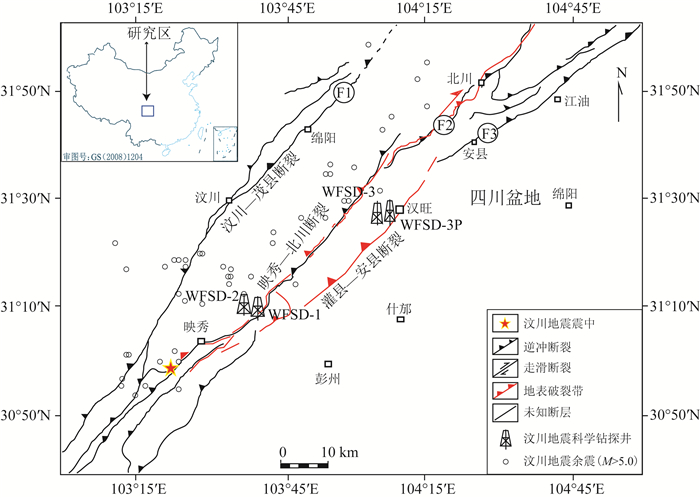
|
图 1 龙门山地区地质构造和部分WFSD位置图 Fig. 1 Geology of the Longmenshan area and locations of part WFSD drilling sites |
WFSD-2钻孔于2009年7月5日正式开钻,第一次为正钻,几乎为垂直向下钻探,由于天气与断裂带岩层原因,该井在1369.8 m中断钻探,2011年2月19日从孔深675.05 m处进行侧钻,钻孔最终深度为2293.56 m,主要取心钻直径为150 mm,终孔直径122 mm.
2 样品采集过程与测试结果 2.1 样品采集过程WFSD-2钻孔中深部流体组分样品采集与测试有严格的流程,以保证测量数据的科学性和准确性.用自动脱气装置对携带深部流体信息的泥浆进行脱气,采用合适的流路设计,实现逐级搅拌和脱气,保证脱气装置与空气隔绝,避免空气污染,使得传输到检测设备的气体来自于钻孔深部,气体分析技术路线见图 2.H2由痕量氢在线分析仪测定,灵敏度:优于0.01 ppm(1 ppm=1 μg·g-1),采样率:1次/分钟~1次/时;Hg由汞在线分析仪测定,检出限:0.5 Pg/L,采样率:1次/秒.泥浆在钻探过程中产生化学反应生成氢气(Zimmer and Erzinger, 1995),钻探过程中添加重晶石可能影响汞浓度,起钻与下钻过程对H2和Hg浓度具有一定影响(Fang et al., 2017; Gong et al., 2017), 但从已有汶川地震深钻随钻气体观测影响因素研究看,这些影响相对较小,有的甚至可以忽略(Yang et al., 2015;Fang et al., 2017).

|
图 2 WFSD-2钻孔H2和Hg浓度分析技术路线 Fig. 2 Technical route of H2 and Hg concentrations analysis for WFSD-2 drill holes |
随钻泥浆脱气H2采样间隔为5 min,共获得近11万个浓度数据,随钻泥浆脱气Hg浓度值为秒值,共获得近1150万个数据.
2.2 钻孔H2和Hg浓度测试结果WFSD-2号孔在311.9~2039.01 m深度H2的测量结果表明,在不同深度表现出多峰分布特征,主要在深度606.18~616.68 m、642.36~676.22 m、720.88~791.01 m、895.47~992.77 m、1240.00~1243.00 m、1383.50~1405.00 m和1560.00~1562.00 m范围段内出现异常高值,变化范围在0.06~58.48 ppm,最高值出现在642.36~676.22 m区段,H2异常区的宽度与量值上存在显著不一致性(表 1).
|
|
表 1 WFSD-2钻孔H2和Hg浓度异常值分布 Table 1 Concentration anomaly distribution of H2 and Hg in WFSD-2 drill holes |
随钻泥浆脱气Hg浓度与H2浓度相似,表现出异常区段特征,在859.63~895.94 m深度范围,Hg浓度分布在0.0050~56.9200 Pg/L之间,均值为15.1088 Pg/L;在1494.55~1524.70 m深度范围,Hg浓度分布在0.0035~54.2547 Pg/L之间,均值为17.6698 Pg/L;在1624.29~1864.98 m深度范围,Hg浓度出现反复异常,最大值为57.5084 Pg/L,Hg异常区的宽度与量值上存在显著不一致性(表 1).
3 讨论H2为易挥发物质,穿透能力强,扩散速度较快(杜乐天,2005),地下H2通过断裂或裂隙上升,特别是新鲜断层面在水-岩反应中生成氢而逸出地壳(Hirose et al., 2011).来自地下深部的Hg,在沿断裂运移过程中,易在断裂带岩石、土壤和地下水中出现Hg的富集(康春丽等,1999),实验表明岩石在受到压力临破裂前有Hg的逸出,因此在地壳中各种断裂处可富集Hg(Varshal et al., 1984).H2和Hg都具有很好的映震效能(张培仁等,1993;魏家珍和申春生,1994),利用H2和Hg浓度的动态异常变化开展地震研究,已经获得了较好的地震前兆异常震例(张炜等,1989;范雪芳等, 2012, 2014).对WFSD-2钻孔中H2、Hg的浓度异常特征与断裂构造、岩石构造特征及地震活动等关系的探讨,是研究H2和Hg浓度异常高值成因的关键.
3.1 钻孔H2浓度与断裂带关系张伟等(2012)通过岩心编录和岩石学、构造地质学等研究,在WFSD-2号孔500~2293 m段厘定出20余条产状不同、规模不等的次级断裂带,断裂带宽度和断裂密度峰值显示FZ600、FZ720、FZ782、FZ817、FZ922、FZ951、FZ1449、FZ1681、FZ2082为主要断裂带(图 3).从图 3可以看出,H2浓度在600~1000 m段出现的高值异常可能与该段的高密集次级断裂(FZ720、FZ782、FZ817、FZ922和FZ951)有关.H2浓度在1383.5~1405.0 m段出现了较为明显异常, 但由于该段岩心取样率较低,没能判断出次级断裂的发育程度,从H2浓度异常推测该段有可能次级断裂比较发育.
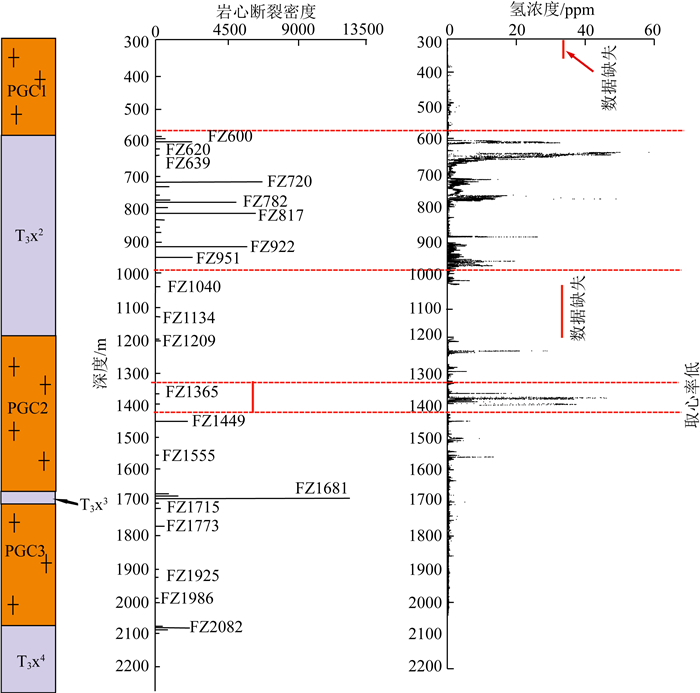
|
图 3 WFSD-2钻孔泥浆脱气H2浓度特征与次级断裂带的关系(PGC:彭灌杂岩;T3x:须家河组;岩心断裂密度图张伟等,2012) Fig. 3 The relationship between concentration characteristics of H2 and primary fault zones in WFSD-2 drill hole (PGC: Pengguan Complex; T3x: Xujiahe Formation; the figure of core fracture density is modified from Zhang et al., 2012) |
刘舒波等(2012)研究WFSD-2号孔350~800 m井段的钻探泥浆气体组分时发现,随钻泥浆气体(He、N2、Ar)浓度异常主要集中在600~800 m深度,该结果与本文给出的H2浓度异常段基本一致.WFSD-2号孔600~800 m区段岩心破裂程度较高,钻探泥浆气体异常可能与钻孔岩心破碎程度存在一定关系(图 4).WFSD-2号孔600~800 m段H2浓度异常还可能与岩心构造特征有关,该段主要由碎裂岩和断层角砾岩组成(张伟,2012;刘舒波等,2012).
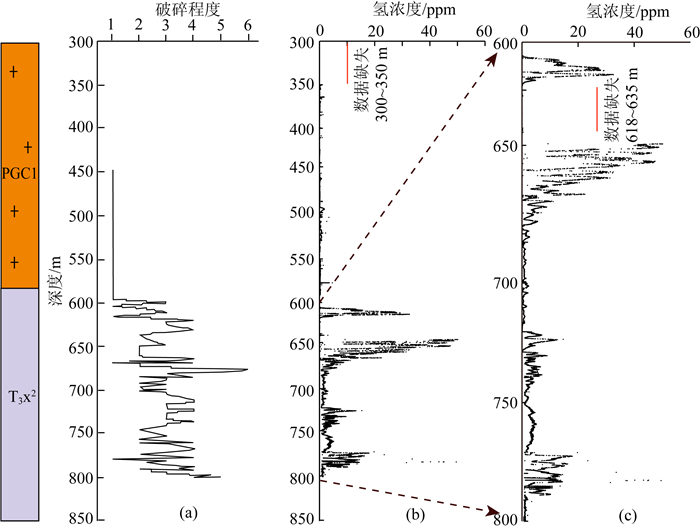
|
图 4 WFSD-2钻孔泥浆脱气H2浓度与岩心破碎程度的关系(PGC:彭灌杂岩;T3x:须家河组;图 4a刘舒波等,2012) (a)钻探岩心破碎程度; (b)随钻氢浓度(300~850 m); (c)随钻氢浓度(600~800 m). Fig. 4 The concentration characteristics of H2 and core fragmentation in WFSD-2 drill hole(PGC: Pengguan Complex; T3x: Xujiahe Formation; Fig. 4a quoted from Liu et al., 2012) (a) shows thedrilling core fracture degree, (b) shows the hydrogen concentration of drilling mud (300~850 m), (c) shows the hydrogen concentration of drilling mud (600~800 m). |
WFSD-2钻孔内H2浓度高值异常与构造环境有关,H2浓度高值异常主要出现在断裂发育区段层位,这可能是由于赋存在岩石中的H2沿着断裂破碎带运移使得钻孔泥浆中H2浓度升高.地震活动也会导致H2浓度出现异常,WFSD-2井孔H2浓度与构造块体边界强震孕育和龙门山断裂上近场显著地震活动有关,从2009年10月至2011年11月H2浓度观测期间,龙门山断裂带以及构造块体边界带发生7次近场中等地震和远场强震(表 2),震前均出现了H2浓度高值异常,说明H2浓度异常与这些地震可能存在一定的关联性(图 5).周晓成等(2017a)研究汶川地震破裂带土壤气中H2浓度时空变化与余震的关系时发现,10个测区土壤气H2浓度的高值主要位于震中附近的映秀和深溪沟测区,时间上土壤气H2浓度的最大值和平均值都呈下降趋势,这与余震活动随时间逐渐衰减一致,地震断裂带裂隙发育为H2排放提供了良好的通道,这佐证了H2浓度异常与地震的密切关系.
|
|
表 2 2009年10月至2011年11月龙门山断裂带M≥4.2地震目录 Table 2 Catalog of M≥4.2 earthquakes on Longmenshan fault zone from October 2009 to November 2011 |

|
图 5 WFSD-2泥浆脱气H2浓度随时间变化趋势图 红色箭头指示地震发生的时间,数字为地震的震级(MS). Fig. 5 Change trend of H2 concentration in WFSD-2 drilling mud Red arrow indicates the time of earthquake, and the number is the magnitude of the earthquake (MS). |
WFSD-2钻孔Hg浓度高值异常成因与H2浓度高值异常存在相似性,与钻孔内断裂破碎带有一定关系,强烈的构造活动改变了地下温度与压力,使各种汞化合物升华.来自地下深部的汞在流体的携带作用下,沿着裂隙上升过程中极易吸附到孔隙或裂隙中.渗透率快速增加,打破了原有地下流体的平衡关系(Xue et al., 2013),破碎带周围的汞在流体运移携带过程中易富集在破碎带上.随钻泥浆中的汞主要为溶解气态汞(Hg0),是深部流体活动携带的气态汞沿汶川地震新破碎带上升产生的(Zhang et al., 2014),另一部分是在构造活动产生的高温高压作用下,富集在老破碎带裂隙中的化合态汞转化为气态汞形成的.要区别新破碎带和老破碎带汞的异常,可以通过汞同位素指标给出(Zhang et al., 2014).
断裂带中的流体对于断层岩物理性质和化学性质的改变及形成机制具有重要作用,同样断层岩的物化性质对断裂带中流体的储存、运移有很大影响(Yang et al., 2016).WFSD-2孔Hg浓度高值异常主要分布在580~940 m和1450~1890 m两个区段.张蕾等(2017)研究结果表明580~940 m和1450~1890 m两个区段岩石构造特征比较特殊,580~940 m段为映秀—北川断裂带,主要为断层角砾岩,1450~1890 m段主要为碎裂岩,钻孔中Hg高值异常可能与岩石构造特征有关(图 6).随钻泥浆总汞高浓度异常有时候未出现在主破裂带段,还可能与老断裂带中的裂隙有热液流体的充填有关(张磊,2015).
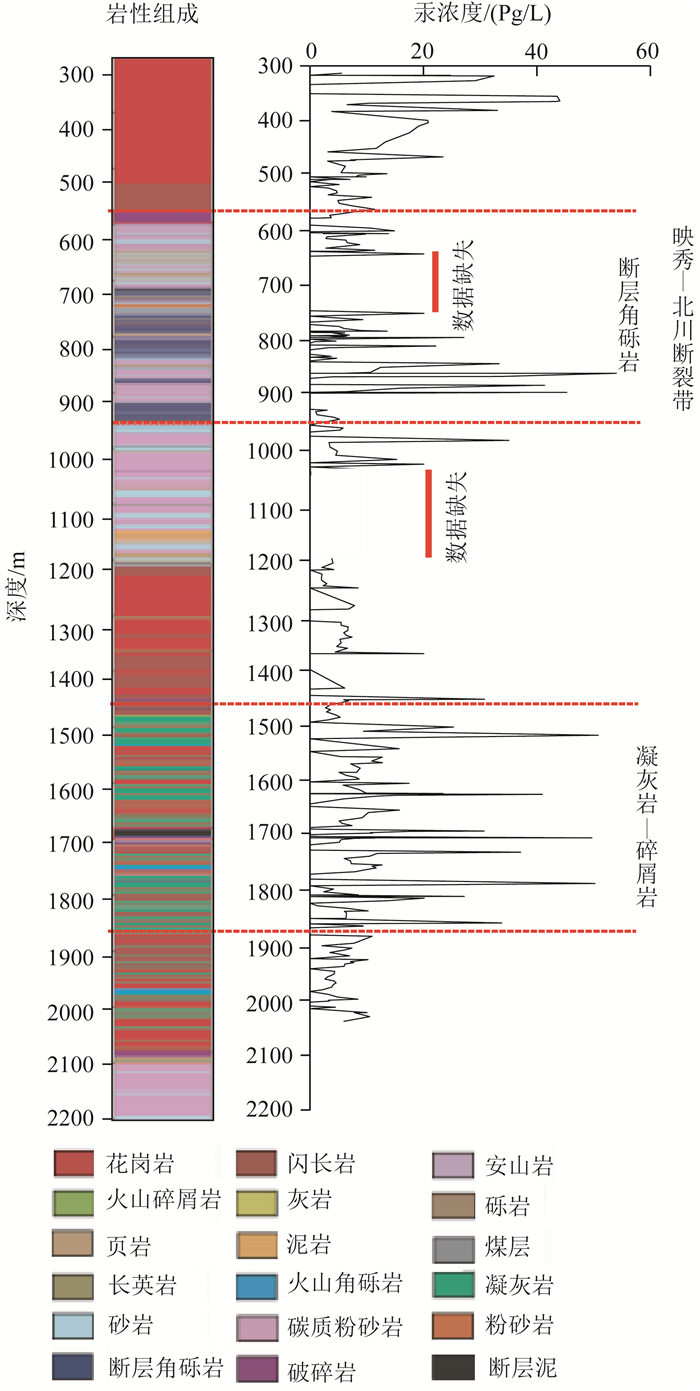
|
图 6 WFSD-2泥浆脱气Hg浓度特征与岩性组成的关系(岩性组成图张蕾等,2017) Fig. 6 The concentration characteristics of Hg and lithologic composition in WFSD-2 (the figure of lithologic composition is from Zhang et al., 2017) |
WFSD-2钻孔内Hg浓度高值异常一方面与钻孔破裂带、岩石构造特征有很大关系,另一方面地震活动同样也可能会导致Hg浓度异常.从表 2统计结果表明,7次地震前都出现了不同形态H2浓度高值异常(图 7),但在2011年7月至2011年11月出现了Hg浓度异常,未发生显著地震事件,说明深部岩层Hg异常形成机制比较复杂,不仅与地震活动有关,还与岩石构造特征所富集汞的背景浓度等有关.汶川地震破裂带Hg脱气平均通量明显高于非活动断裂地区相应的土壤气中气体通量(周晓成等,2017b),最大值分布在破裂带两端,而汶川地震的余震有明显的分段性,分为南段和北段,较大的余震多发生在破裂带的两端.汶川深钻气体测量表明,气体异常一般在余震前数天出现,并且震后持续多天,不同气体组分所呈现的异常规律并不相同,且异常数量随着震中距的增加而明显减少(周晓成,2011),表明地壳流体的活动与地震活动实际上是与构造活动伴生的关系(温静,2010).

|
图 7 WFSD-2泥浆脱气Hg浓度随时间变化趋势图 红色箭头指示地震发生的时间,数字为地震的震级(MS). Fig. 7 Change trend of Hg concentration in WFSD-2 drilling mud The red arrow indicates the time of earthquake, and the number is the magnitude of the earthquake (MS). |
对汶川地震在WFSD-2井孔主滑移带深度还存在不同看法,温静(2010)研究结果表明WFSD-2的汶川地震主滑移带深度约为1360 m,张伟等(2012)认为WFSD-2的汶川地震主滑移带可能处于发育断层泥的FZ1134(1134.23~1135.1 m)、FZ1449(1448.83~1452.92 m)、FZ1681(1668.79~1698.66 m)之中,这种认识可能与龙门山断裂带的断层倾角有一定关系,映秀—北川断裂在WFSD-1号孔的断层倾角约为62°(温静,2010)或65°(王焕,2010).若断层倾角为62°,推算出WFSD-2井孔主滑移带位于1360 m处;若断层倾角为65°,则推算出主滑移带位于1440 m处.
大量研究表明,在钻孔破裂带发育段气体含量会显著増加(Erzinger et al., 2006;Tretner et al., 2008;唐力君等,2013;Gong et al., 2015;Yang et al., 2015),WFSD-2在1360 m处出现了H2浓度异常高值,认为WFSD-2井孔1360 m处是破裂带发育段.同时,WFSD-2钻探到1369.80 m时, 造成卡钻、钻具断裂及套管断裂事故被迫中断施工,也验证了该层段为破裂带.
WFSD-2在钻探到1369.80 m中断后进行了侧钻,如果按照映秀—北川断层倾角为62°来推算,汶川地震在WFSD-2侧钻主滑移带深度约1450 m处,H2和Hg浓度在该层位也出现了高值异常,认为1450 m为汶川地震在WFSD-2侧钻的主滑移带也是可能的.当然,要给出WFSD-2钻孔地震主滑移带的确切位置仍然比较困难,需要更多证据进行证明(王焕,2010).
4 结论汶川地震断裂带科学钻探工程(WFSD)为我们在深大断裂带开展深部流体特征与构造带、地震关系研究提供了极佳条件,通过对随钻泥浆气体H2和Hg浓度分析,结合次级断裂带、岩石构造特征和远场强震及近场中等地震活动,得出以下认识:
(1) WFSD-2钻孔H2和Hg浓度高异常大多出现在次级断裂或碎裂岩、断层角砾岩及断层泥处,表明H2和Hg浓度异常与次级断裂和岩石构造性质有较大关系,并以断裂带或破碎带为通道运移而产生高值异常.
(2) 深部流体对活动构造带的识别具有指示意义,通过对WFSD-2钻孔H2和Hg浓度分析,推测汶川地震主滑移带可能位于WFSD-2正钻孔1360 m处或侧钻孔1450 m处,表明随钻流体特征是识别地下裂隙带、破碎带或断裂带的途径之一,但确切的主滑移带深度还需要更多的研究证据来确定.
(3) WFSD-2钻孔H2和Hg浓度观测期间,在构造块体边界带以及龙门山断裂带发生的7次远场强震和近场中等地震前,在钻孔断裂带或破碎带观测到的H2和Hg浓度均出现了高值异常,表明H2和Hg浓度异常还可能与构造块体边界带强震活动和断裂带近场中等地震活动有关.
本文研究了随钻泥浆气体H2和Hg浓度与次级断裂带、岩石构造特征及地震活动的关系,为分析大震过程中深部流体活动行为提供了地球化学特征依据.但利用H2和Hg浓度区分古老地震形成的断裂与现今地震形成的断裂还存在不确定性.一般认为深部存储的H2可以沿古老地震形成的断裂裂隙逸出(Giardini et al., 1976; Sato and McGee, 1985),H2也可以由现今地震形成的新断裂面直接产生(Saruwatari et al., 2004; Wiersberg and Erzinger, 2008).而依据汞的同位素特征,则可用Hg浓度异常区分哪些断裂是现今地震形成的,哪些断裂是古地震形成的(Zhang et al., 2014).然而,断裂带深部气体来源、赋存与运移机理比较复杂,仍有众多科学问题有待深入研究.
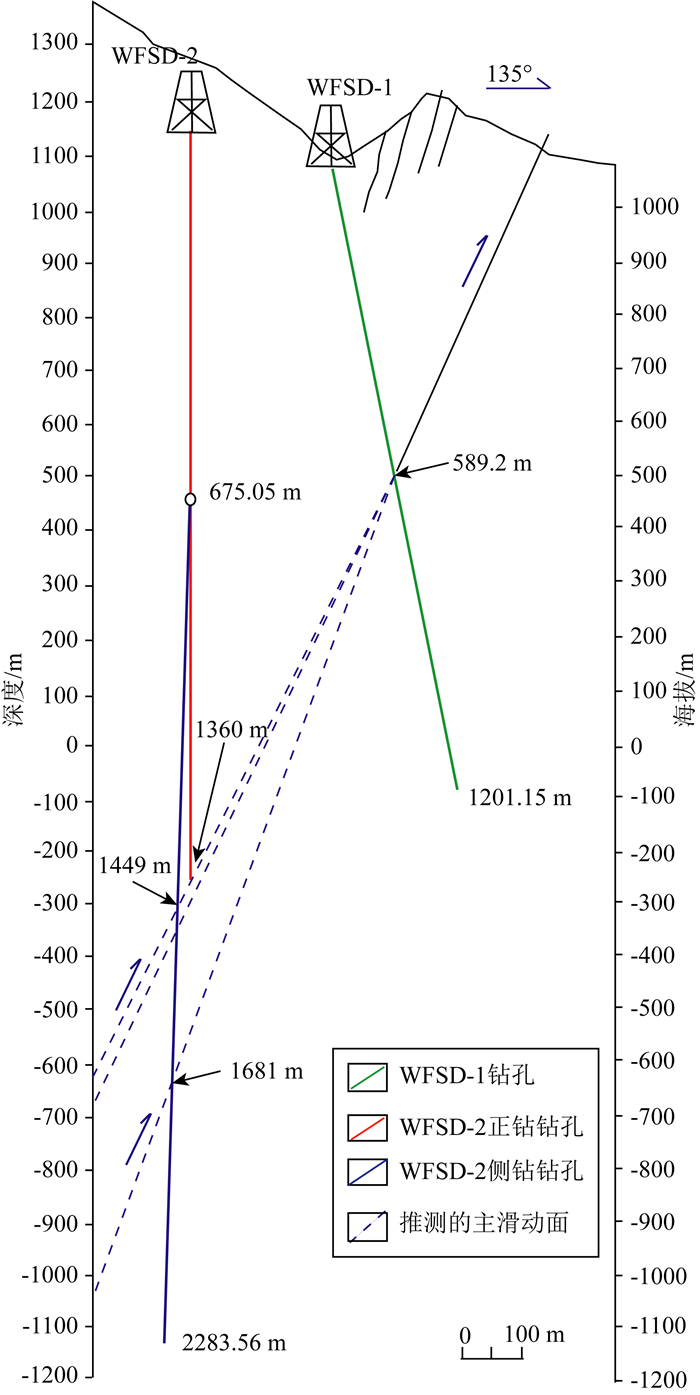
|
图 8 WFSD-2井孔构造剖面(改自张伟等,2012) Fig. 8 Structural section of WFSD-2 drill hole (modified from Zhang et al., 2012) |
感谢"汶川地震断裂带科学钻探(WFSD)"项目组, 特别是许志琴院士和李海兵研究员的帮助与支持,感谢评审专家提出的宝贵意见与建议.
Aquilina L, Brach M.
1995. Characterization of Soultz hydrochemical system: WELCOM (well chemical on-line monitoring) applied to deepening of GPK-1 borehole. Geothermal Science & Technology, 4(4): 239-251.
|
|
Aquilina L, Baubron J C, Defoix D, et al.
1998. Characterization of gases in sedimentary formations through monitoring during drilling and core leaching (Balazuc borehole, Deep Geology of France Programme). Applied Geochemistry, 13(6): 673-686.
DOI:10.1016/S0883-2927(98)00008-0 |
|
Carpenter B M, Marone C, Saffer D M.
2011. Weakness of the San Andreas Fault revealed by samples from the active fault zone. Nature Geoscience, 4(4): 215-254.
DOI:10.1038/ngeo1131 |
|
Carpenter B M, Kitajima H, Sutherland R, et al.
2014. Hydraulic and acoustic properties of the active Alpine Fault, New Zealand: Laboratory measurements on DFDP-1 drill core. Earth and Planetary Science Letters, 390: 45-51.
DOI:10.1016/j.epsl.2013.12.023 |
|
Du L T.
2005. Significance of earth degassing and its research progress. Geological Review, 51(2): 174-180.
|
|
Erzinger J, Wiersberg T, Zimmer M.
2004. Real-time mud gas logging during of the SAFOD pilot hole in Parkfield, CA. Geophysical Research Letters, 31(15): L13S18.
DOI:10.1029/2003GL019395 |
|
Erzinger J, Wiersberg T, Zimmer M.
2006. Real-time mud gas logging and sampling during drilling. Geofluids, 6(3): 225-233.
|
|
Fan X F, Huang C L, Liu G J, et al.
2012. Primary analysis on observation data of trace hydrogen at Xiaxian, Shanxi. Earthquake Research in Shanxi(3): 7-12.
|
|
Fan X F, Li Z H, Liu G J, et al.
2014. Test of observation methods on the concentration of hydrogen in fault gas. Earthquake Research in China, 30(1): 43-54.
|
|
Fang Z, Liu Y W, Yang D X, et al.
2017. Real-time hydrogen mud logging during the Wenchuan earthquake fault scientific drilling project (WFSD), holes 2 and 3 in SW China. Geosciences Journal.
DOI:10.1007/s12303-017-0068-7 |
|
Giardini A A, Subbarayudu G V, Melton C E.
1976. The emission of occluded gas from rocks as a function of stress: Its possible use as a tool for predicting earthquakes. Geophysical Research Letters, 3(6): 355-358.
DOI:10.1029/GL003i006p00355 |
|
Gong Z, Li H B, Lao C L, et al.
2015. Real-time drilling mud gas monitoring records seismic damage zone from the 2008 MW7. 9 Wenchuan earthquake. Tectonophysics, 639: 109-117.
|
|
Gong Z, Li H B, Tang L J, et al.
2017. Real time drilling mud gas response to small-moderate earthquakes in Wenchuan earthquake Scientific Drilling Hole-1 in SW China. Journal of Asian Earth Sciences, 138: 416-426.
DOI:10.1016/j.jseaes.2017.02.026 |
|
Hilton D R, Craig H.
1989. The Siljan Deep Well: Helium isotope results. Geochimica et Cosmochimica Acta, 53(12): 3311-3316.
DOI:10.1016/0016-7037(89)90110-5 |
|
Hirose T, Kawagucci S, Suzuki K.
2011. Mechanoradical H2 generation during simulated faulting: Implications for an earthquake-driven subsurface biosphere. Geophysical Research Letters, 38(17): L17303.
DOI:10.1029/2011GL048850 |
|
Kang C L, Du J G, Li S Q.
1999. Anomaly characteristics of mercury associated with moderately strong earthquake. Earthquake, 4: 352-358.
|
|
Lao C L, Tang L J, Luo L Q, et al.
2016. Geochemical features in Drill Hole WFSD-4S. Geology in China, 43(5): 1721-1728.
|
|
Li H B, Fu X F, Van Der Woerd J, et al.
2008. Co-seismic surface rupture and dextral-slip oblique thrusting of the MS8.0 Wenchuan earthquake. Acta Geologica Sinica, 82(12): 1623-1643.
|
|
Li H B, Wang H, Xu Z Q, et al.
2013. Characteristics of the fault-related rocks, fault zones and the principal slip zone in the Wenchuan Earthquake Fault Scientific Drilling Project Hole-1 (WFSD-1). Tectonophysics, 584: 23-42.
DOI:10.1016/j.tecto.2012.08.021 |
|
Li H B, Xu Z Q, Wang H, et al.
2013. The Principle Slip Zone of the 2008 Wenchuan earthquake: A thrust fault oblique cutting the Yingxiu-Beichuan fault zone. Geology in China, 40(1): 121-139.
|
|
Li H B, Xu Z Q, Niu Y X, et al.
2014. Structural and physical property characterization in the Wenchuan earthquake Fault Scientific Drilling project-hole 1 (WFSD-1). Tectonophysics, 2014, 619-620: 86-100.
|
|
Li H B, Xue L, Brodsky E E, et al.
2015. Long-term temperature records following the MW7.9 Wenchuan (China) earthquake are consistent with low friction. Geology, 43(2): 163-166.
DOI:10.1130/G35515.1 |
|
Li H B, Wang H, Yang G, et al.
2016. Lithological and structural characterization of the Longmen Shan fault belt from the 3rd hole of the Wenchuan Earthquake Fault Scientific Drilling project (WFSD-3). International Journal of Earth Sciences, 105(8): 2253-2272.
DOI:10.1007/s00531-015-1285-9 |
|
Li S Q, Sun Q, Luo L Q, et al.
2006. Relationship between earthquakes and the gas geochemical anomalies in the 0~2000 m mud of Chinese Continental Scientific Drilling hole. Acta Petrologica Sinica, 22(7): 2095-2102.
|
|
Liu S B, Tang L J, Sun Q, et al.
2012. Variation of drilling mud gas components at 350-800 m interval of No.2 borehole of scientific drilling for Wenchuan seismic faulted zone. Geophysical and Geochemical Exploration, 36(1): 48-53.
|
|
Luo L Q, Sun Q, Zhan X C.
2004. 0-2000m fluid profiles and sources in Chinese Continental Scientific Drilling Project. Acta Petrologica Sinica, 20(1): 185-191.
|
|
Saruwatari K, Kameda J, Tanaka H.
2004. Generation of hydrogen ions and hydrogen gas in quartz-water crushing experiments: An example of chemical processes in active faults. Physics and Chemistry of Minerals, 31(3): 176-182.
DOI:10.1007/s00269-004-0382-2 |
|
Sato M, McGee K A. 1981. Continuous Monitoring of Hydrogen on the south flank of Mount St. Helens. //Lipman P W, Mullineaux D R eds. The 1980 Eruptions of Mount St. Helens. Washington: U. S. Geological Survey Professional Paper, 1250.
|
|
Song S R, Kuo L W, Yeh E C, et al.
2007. Characteristics of the lithology, fault-related rocks and fault zone structures in TCDP Hole-A. Terrestrial, Atmospheric and Oceanic Sciences, 18(2): 243-269.
DOI:10.3319/TAO.2007.18.2.243(TCDP) |
|
Tanaka H, Chen W M, Kawabata K, et al.
2007. Thermal properties across the Chelungpu fault zone and evaluations of positive thermal anomaly on the slip zones: Are these residuals of heat from faulting?. Geophysical Research Letters, 34(1): L01309.
DOI:10.1029/2006GL028153 |
|
Tang L J, Wang G, Wang J, et al.
2013. Responding features of fluids during drilling of the main fracture zone in WFSD-1 hole. Acta Geoscientica Sinica, 4(1): 95-102.
|
|
Tapponnier P, Xu Z P, Roger F, et al.
2001. Oblique stepwise rise and growth of the Tibet Plateau. Science, 294(5547): 1671-1677.
DOI:10.1126/science.105978 |
|
Tretner A, Zimmer M, Erzinger J, et al.
2008. Real-time drill mud gas logging at the USDP-4 drilling, Unzen volcano, Japan. Journal of Volcanology and Geothermal Research, 175(1-2): 29-34.
|
|
Varshal G M, Sobolev G A, Barsukov V L, et al.
1984. Separation of volatile components from rocks under mechanical loading as the source of hydrogeochemical anomalies preceding earthquakes. Pure and Applied Geophysics, 122(2-4): 463-477.
|
|
Wang H. 2010.
The structure characteristics of the Wenchuan earthquake fault zone and its relationship with seismic activity. Beijing: China University of Geosciences.
|
|
Wang H, Li H B, Si J J, et al.
2014. Internal structure of the Wenchuan earthquake fault zone, revealed by surface outcrop and WFSD-1 drilling core investigation. Tectonophysics, 619-620: 101-114.
DOI:10.1016/j.tecto.2013.08.029 |
|
Wei J Z, Shen C S.
1994. Analysis of typical earthquake cases and evaluation of earthquake-reflection effect in Hg observation in Beijing and its adjacent region. Earthquake(3): 44-49.
|
|
Wen J. 2010.
The relationship between earthquakes and the gas geochemical anomalies in the mud of Wenchuan earthquake faults scientific drilling hole. Beijing: China University of Geosciences.
|
|
Wiersberg T, Erzinger J.
2007. A helium isotope cross-section study through the San Andreas Fault at seismogenic depths. Geochemistry, Geophysics, Geosystems, 8(1): C01002.
DOI:10.1029/2006GC00138 |
|
Wiersberg T, Erzinger J.
2008. Origin and spatial distribution of gas at seismogenic depths of the San Andreas Fault from drill-mud gas analysis. Applied Geochemistry, 23(6): 1675-1690.
DOI:10.1016/j.apgeochem.2008.01.012 |
|
Wiersberg T, Erzinger J.
2011. Chemical and isotope compositions of drilling mud gas from the San Andreas Fault Observatory at Depth (SAFOD) boreholes: Implications on gas migration and the permeability structure of the San Andreas Fault. Chemical Geology, 284(1-2): 148-159.
DOI:10.1016/j.chemgeo.2011.02.016 |
|
Xu Z Q.
2004. The scientific goals and investigation progresses of the Chinese Continental Scientific Drilling Project. Acta Petrologica Sinica, 20(1): 1-8.
|
|
Xu Z Q, Yang J S, Zhang Z M, et al.
2005. Completion and achievement of the Chinese Continental Scientific Drilling (CCSD) Project. Chinese Geology, 32(2): 177-183.
|
|
Xu Z Q, Li H B, Wu Z L.
2008. Wenchuan earthquake and scientific drilling. Acta Geologica Sinica, 82(12): 1613-1622.
|
|
Xue L, Li H B, Brodsky E E, et al.
2013. Continuous permeability measurements record healing inside the Wenchuan earthquake fault zone. Science, 340(6140): 1555-1559.
DOI:10.1126/science.1237237 |
|
Yang D X, Zhang L, Liu Y W, et al.
2015. Mercury indicating inflow zones and ruptures along the Wenchuan MS8.0 earthquake fault. Chinese Journal of Geochemistry, 34(2): 201-207.
DOI:10.1007/s11631-014-0028-0 |
|
Yang T, Yang X S, Duan Q B, et al.
2016. Rock magnetic expression of fluid infiltration in the Yingxiu-Beichuan fault (Longmen Shan thrust belt, China). Geochemistry, Geophysics, Geosystems, 17(3): 1065-1085.
DOI:10.1002/2015GC006095 |
|
Zhang L, Liu Y W, Guo L S, et al.
2014. Isotope geochemistry of mercury and its relation to earthquake in the Wenchuan Earthquake Fault Scientific Drilling Project Hole-1 (WFSD-1). Tectonophysics, 619-620: 79-85.
DOI:10.1016/j.tecto.2013.08.025 |
|
Zhang L. 2015.
Geochemistry of mercury in Wenchuan earthquake fault zone. Beijing: Institute of Geophysics, China Earthquake Administration.
|
|
Zhang L. 2017.
Rock magnetic record of earthquake faulting within WFSD-2 borehole cores from the Longmen Shan thrust belt and its implications. Beijing: State Key Laboratory of Geological Processes and Mineral Resources, and Institute of Geomechanics, Chinese Academy of Geological Science.
|
|
Zhang L, Sun Z M, Li H B, et al.
2017. Magnetic susceptibility of WFSD-2 borehole cores from the Longmenshan thrust belt and its implications for great seismic activity. Chinese Journal of Geophysics, 60(1): 225-239.
DOI:10.6038/cjg20170119 |
|
Zhang P R, Wang J H, Sun F M.
1993. Hydrogen-a sensitive element to predictable earthquake. Seismology and Geology, 15(1): 69-77.
|
|
Zhang W, Shen C S, Xing Y A, et al.
1989. A new index of short-term and imminent earthquake anomalies-content of mercury. Earthquake Research in China, 5(4): 13-19.
|
|
Zhang W, Li H B, Huang Y, et al.
2012. Lithologic characteristics and fault zone structure revealed by No.2 hole cores of the Wenchuan Earthquake Fault Zone Scientific Drilling (WFSD-2). Geological Bulletin of China, 31(8): 1201-1218.
|
|
Zhou X C. 2011.
Gas geochemistry in Western Sichuan related to 12 May 2008 Wenchuan MS8.0 earthquake. Hefei: University of Science and Technology of China.
|
|
Zhou X C, Shi H Y, Chen C, et al.
2017a. Spatial-temporal variations of H2 concentration in soil gas in the seismic fault zone produced by the Wenchuan MS8.0 earthquake. Advances in Earth Science, 32(8): 818-827.
DOI:10.11867/j.issn.1001-8166.2017.08.0818 |
|
Zhou X C, Sun F X, Chen Z, et al.
2017b. Degassing of CO2, CH4, Rn and Hg in the rupture zones produced by Wenchuan MS8.0 earthquake. Acta Petrologica Sinica, 33(1): 291-303.
|
|
Zimmer M, Erzinger J.
1995. On the geochemistry of gases in formation and drilling fluids—results from the KTB. Sci. Drill, 5: 101-109.
|
|
杜乐天.
2005. 地球排气作用的重大意义及研究进展. 地质论评, 51(2): 174–180.
|
|
范雪芳, 黄春玲, 刘国俊, 等.
2012. 山西夏县痕量氢观测资料的初步分析. 山西地震(3): 7–12.
|
|
范雪芳, 李自红, 刘国俊, 等.
2014. 断层氢气浓度观测技术试验研究. 中国地震, 30(1): 43–54.
|
|
康春丽, 杜建国, 李圣强.
1999. 中强地震活动中汞的异常特征. 地震, 4: 352–358.
DOI:10.3969/j.issn.1000-3274.1999.04.006 |
|
劳昌玲, 唐力君, 罗立强, 等.
2016. WFSD-4S孔流体地球化学特征. 中国地质, 43(5): 1721–1728.
|
|
李海兵, 付小方, Van Der WoerdJ, 等.
2008. 汶川地震(MS8.0)地表破裂及其同震右旋斜向逆冲作用. 地质学报, 82(12): 1623–1643.
DOI:10.3321/j.issn:0001-5717.2008.12.002 |
|
李海兵, 许志琴, 王焕, 等.
2013. 汶川地震主滑移带(PSZ):映秀—北川断裂带内的斜切逆冲断裂. 中国地质, 40(1): 121–139.
|
|
李圣强, 孙青, 罗立强, 等.
2006. 中国大陆科学钻探主孔0~2000米流体地球化学异常与地震的关系. 岩石学报, 22(7): 2095–2102.
|
|
刘舒波, 唐力君, 孙青, 等.
2012. 汶川地震断裂带科学钻探工程2号孔350~800m井段的钻探泥浆气体组分变化. 物探与化探, 36(1): 48–53.
DOI:10.11720/wtyht.2012.1.10 |
|
罗立强, 孙青, 詹秀春.
2004. 中国大陆科学钻探主孔0~2000米流体剖面及流体地球化学研究. 岩石学报, 20(1): 185–191.
|
|
唐力君, 王广, 王健, 等.
2013. 汶川地震断裂带科学钻探工程一号孔主断层的随钻流体响应特征. 地球学报, 34(1): 95–102.
DOI:10.3975/cagsb.2013.01.09 |
|
王焕. 2010.
汶川地震断裂带结构特征及其与地震活动性的关系. 北京: 中国地质大学.
|
|
魏家珍, 申春生.
1994. 首都圈地区汞测量典型震例剖析及其映震效能评价. 地震(3): 44–49.
|
|
温静. 2010.
汶川地震断裂带科学钻探地下流体气体组分异常与余震的关系研究. 北京: 中国地质大.
|
|
许志琴.
2004. 中国大陆科学钻探工程的科学目标及初步成果. 岩石学报, 20(1): 1–8.
|
|
许志琴, 杨经绥, 张泽明, 等.
2005. 中国大陆科学钻探终孔及研究进展. 中国地质, 32(2): 177–183.
|
|
许志琴, 李海兵, 吴忠良.
2008. 汶川地震和科学钻探. 地质学报, 82(12): 1613–1622.
DOI:10.3321/j.issn:0001-5717.2008.12.001 |
|
张磊. 2015.
汶川地震断裂带汞的地球化学特征. 北京: 中国地震局地球物理研究所.
|
|
张蕾. 2017.
龙门山构造带WFSD-2钻孔岩心地震断裂作用的岩石磁学记录及其指示意义. 北京: 地质过程与矿产资源国家重点实验室, 中国地质科学院地质力学研究所.
|
|
张蕾, 孙知明, 李海兵, 等.
2017. 龙门山构造带WFSD-2钻孔岩心磁化率特征及其对大地震活动的响应. 地球物理学报, 60(1): 225–239.
DOI:10.6038/cjg20170119 |
|
张培仁, 王基华, 孙凤民.
1993. 氢-预报地震的灵敏元素. 地震地质, 15(1): 69–77.
|
|
张炜, 申春生, 邢玉安, 等.
1989. 地震短临异常新指标的探索——汞浓度探测. 中国地震, 5(4): 13–19.
|
|
张伟, 李海兵, 黄尧, 等.
2012. 汶川地震断裂带科学钻探2号孔(WFSD-2)岩性特征和其断裂带的结构研究. 地质通报, 31(8): 1201–1218.
|
|
周晓成. 2011.
汶川MS8.0地震后川西地区的气体地球化学. 合肥: 中国科技大学.
|
|
周晓成, 石宏宇, 陈超, 等.
2017a. 汶川MS8.0地震破裂带土壤气中H2浓度时空变化. 地球科学进展, 32(8): 818–827.
DOI:10.11867/j.issn.1001-8166.2017.08.0818 |
|
周晓成, 孙凤霞, 陈志, 等.
2017b. 汶川MS8.0地震破裂带CO2、CH4、Rn和Hg脱气强度. 岩石学报, 33(1): 291–303.
|
|
 2018, Vol. 61
2018, Vol. 61

